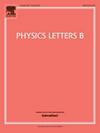普通的太初黑洞会是暗物质吗?
IF 4.5
2区 物理与天体物理
Q1 ASTRONOMY & ASTROPHYSICS
引用次数: 0
摘要
最近,保罗·戴维斯(Paul Davies)及其同事提出了一项建议。D 111(2025)号[10,103512]规则的原始黑洞(RPBHs)形成稳定的零温度残余物,从而可能构成暗物质。虽然基本长度尺度的引入确实调节了霍金温度,阻止了它的发散,但我们证明了这种rpbh的蒸发时间尺度是无限的。这一结果对标准绝热演化和准静态演化下的解析规则黑洞时空具有普遍性。因此,rpbh在任何有限的时间内都不会达到真正的残余状态,而是以非零光度的缓慢蒸发物体的形式持续存在。当考虑到这些近残余物的宇宙种群的联合发射时,发现所产生的辐射违反了来自宇宙微波背景和河外伽马射线背景的严格观测约束。因此,低质量rpbh不是可行的暗物质候选者。本文章由计算机程序翻译,如有差异,请以英文原文为准。
Could regular primordial black holes be dark matter?
The recent proposal proposed by Paul Davies and colleagues [Phys. Rev. D 111 (2025) no.10, 103512] that regular primordial black holes (RPBHs) form stable, zero-temperature remnants and could thereby constitute dark matter is critically examined. While the introduction of a fundamental length scale indeed regulates the Hawking temperature, preventing its divergence, we show that the evaporation timescale for such RPBHs is infinite. This result holds generically for analytic regular black hole spacetimes under standard adiabatic and quasi-static evolution. Consequently, RPBHs never actually reach a true remnant state within any finite time, but instead persist as slowly evaporating objects with a non-zero luminosity. When the combined emission from a cosmological population of these near-remnants is considered, the resulting radiation is found to violate stringent observational constraints from the cosmic microwave background and extragalactic gamma-ray backgrounds. Therefore, low-mass RPBHs are not viable dark matter candidates.
求助全文
通过发布文献求助,成功后即可免费获取论文全文。
去求助
来源期刊

Physics Letters B
物理-物理:综合
CiteScore
9.10
自引率
6.80%
发文量
647
审稿时长
3 months
期刊介绍:
Physics Letters B ensures the rapid publication of important new results in particle physics, nuclear physics and cosmology. Specialized editors are responsible for contributions in experimental nuclear physics, theoretical nuclear physics, experimental high-energy physics, theoretical high-energy physics, and astrophysics.
 求助内容:
求助内容: 应助结果提醒方式:
应助结果提醒方式:


